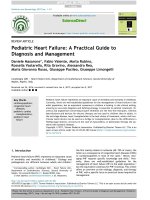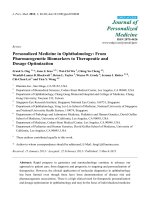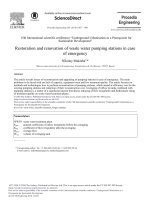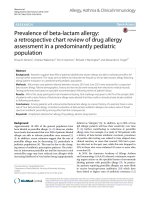Pediatric emergency medicine trisk 0664 0664
Bạn đang xem bản rút gọn của tài liệu. Xem và tải ngay bản đầy đủ của tài liệu tại đây (75.32 KB, 1 trang )
aspirin, anticholinergics, and sympathomimetics (e.g., amphetamines, cocaine,
and methylenedioxymethamphetamine or “ecstasy”), may present with severe
hyperpyrexia (see Chapter 102 Toxicologic Emergencies ). Additional uncommon
febrile drug reactions include the serotonin syndrome occurring with the
combined use of monoamine oxidase inhibitors and analgesic, antitussive, or
psychotropic serotonergic medications (e.g., meperidine, dextromethorphan,
fluoxetine), and the neuroleptic malignant syndrome. History of environmental
heat exposure preceding severe hyperpyrexia may represent heat stroke rather
than an infectious cause for the increased temperature (see Chapter 90
Environmental Emergencies, Radiological Emergencies, Bites and Stings ).
Therapeutic exposure to the antiepileptic drug zonisamide can result in
oligohydrosis and severe resultant heat stroke. Immunizations (such as the
conjugate pneumococcal or diphtheria, tetanus, acellular pertussis vaccine) are
associated with fever that usually occurs within 48 hours. Fever, at times
accompanied by a faint rash, may occur 7 to 10 days after immunization with the
live-attenuated measles vaccine or the measles–mumps–rubella vaccine. In
addition, autoimmune and inflammatory processes should be considered
including but not limited to juvenile idiopathic arthritis (JIA), familial recurrent
fever syndrome, and Kawasaki disease, a vasculitis of childhood of unknown
origin which can result in cardiac complications if untreated (see Chapter 101
Rheumatologic Emergencies ). Classic Kawasaki disease should be considered in
children with fevers for 4 to 5 days and at least four of the following: (1)
erythema and cracking of the lips, strawberry tongue, and/or erythema of oral and
pharyngeal mucosae, (2) bilateral bulbar conjunctival injection without exudate,
(3) maculopapular, erythroderma or erythema multiforme-like rash, (4) erythema
and edema of hands and feet in acute phase or periungal desquamation in
subacute phase, and (5) cervical lymphadenopathy (≥1.5 cm in diameter), usually
unilateral.
Fevers of unknown origin (FUOs) are defined as daily temperatures of 38.3°C
(101°F) or higher for at least 8 days without discernible cause. Many children
evaluated for FUOs actually have consecutive unrelated viral illnesses or
unusually prolonged courses of common viral illnesses. Infections commonly
causing prolonged fever in children include Epstein–Barr virus, cytomegalovirus,
osteomyelitis, Bartonellosis (catscratch disease), UTIs, intra-abdominal abscess,
and tuberculosis. Although consecutive viral illnesses are the most common
etiology for recurrent fevers in a child, occasional cases are due to periodic fever
syndromes that are marked by recurrence of fever at regular intervals, affecting
the child over a period of years. Kawasaki disease should also be considered.









